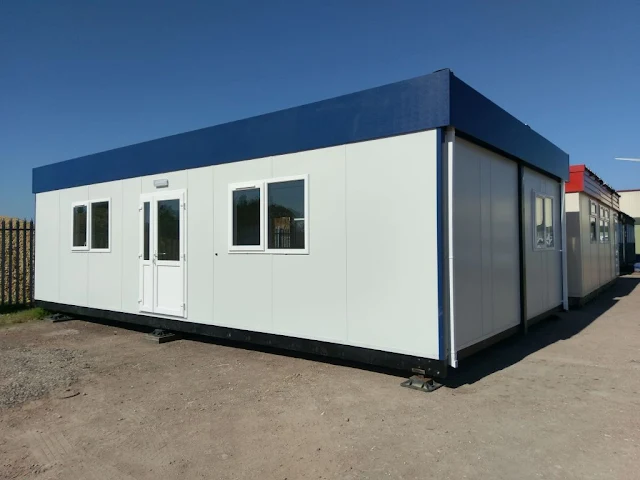Ad Code
Translate
Smart strategies for trading on crypto exchanges
October 20, 2025
Five Do’s For a Healthy Turnover That Bolsters Talent-Retention
October 20, 2025
Discover Honeybee Pharmacy (2025 Guide Important Consumer Tips)
October 14, 2025
What is Ozempic (semaglutide)? (Updated in 2025)
January 30, 2025
Posture Bra: Improving Back Support and Comfort
October 20, 2025
How To Find Suitable Properties In Cyprus?
October 20, 2025
10 Effective Strategies to Improve Domain Authority of Your Website
October 20, 2025
A Comprehensive Guide to Temporary Buildings
Zizo Gala-Mkhize
February 02, 2024
Temporary buildings are the solution that every sector needs right now. In the past, they were mainly used by the military industry for short-term uses, but most commercial and health sectors are currently using this long-lasting, cost-effective solution. The structures only require a few materials to set up. They use recycled materials, making them perfect for quick and easy construction. On top of that, they lack columns and rows, which is ideal for storing large items.
Let's discuss what you need to know about temporary buildings without further discussion.
Different Sectors Using Temporary Buildings
Various sectors make use of temporary buildings. They include the following.
- Health sector – Due to the pandemic, most hospitals worldwide are overwhelmed with patients. Therefore, they need quick fixes to assist with patient admission and equipment storage. Temporary structures are advantageous in this situation since they offer room for numerous beds and patients. The ideal temporary structures, in this instance, are insulated temporary structures, PVC structures, and temporary tents. Most of the time, they offer enough room to accommodate numerous beds and plenty of medical equipment.
- Agricultural sector – Storage space is an essential need of the farming industry, and this can be easily met using temporary buildings from Smart-Space. They help store harvested foods and machinery and, at times, act as homes for farmers. Most importantly, temporary structures are used as greenhouses and provide the perfect agricultural space. In this case, the structures are just placed on the ground to make them easier to shift in the future.
- Education sector – The education sector has significantly improved in providing a conducive space for learners by using temporary buildings. They have adopted temporary offices, classrooms, halls, parking spaces, and more.
- Military sector – The military industry has used temporary structures for quite some time. At first, they were simply temporary tents for the storage of equipment. Still, temporary offices, dormitories, halls, and storage facilities made of different materials, such as fabric and steel, are standard.
- Commercial sector – Since people need homes and businesses need buildings, buildings, and construction are always in demand. To store goods and facilitate operations, the service providers use temporary structures. For instance, a construction business might cover specific railway segments and continue working from inside until the job is finished. The temporary buildings chosen must be relatively transportable. Therefore, they will select tents and moveable modular constructions instead of using temporary steel structures.
The Benefits of Using Temporary Buildings
Temporary buildings may be utilized in almost any business, from construction to entertainment, and they are a rapid and affordable option to expand your functional space. Some advantages of temporary buildings are listed below.
- They are cost-effective and take a short time to construct – Temporary structures are easier to build and take less time to complete; depending on the project's complexity, some may even just require a few days. Businesses with limited resources trying to enter the market might consider this alternative. Setting up a temporary building takes minimal time, so your firm will be operational quickly.
- They are environmentally friendly – The beauty of temporary buildings is that they protect the environment. Right from the start, there is no disturbance of the ground required. The structure is placed atop the land, meaning the setting below will be safe. Secondly, the materials used for construction are primarily recycled and good for the environment, thus protecting nature.
Temporary buildings can be used for a single weekend or several years. Some examples of temporary buildings include Tents, Marquees, Garden sheds, and racks.
Temporary buildings are often used when a space solution is needed quickly. Some examples of where temporary buildings are used include:
- Large sporting events
- Hospitality
- Exhibition space
Here are some tips for planning temporary buildings:
- Organize the project into manageable phases
- Make a reasonable schedule
- Ensure the budget accounts for all project costs
- Careful planning is necessary to guarantee adherence to regulations, structural safety, functional alignment, efficient resource allocation, and cost control.
Conclusion
Almost all sectors can benefit from temporary buildings since they are easy and cheap to construct. If you plan to build or rent one, work with reputable firms for a more straightforward process. Above all, the preceding article provides some of the necessary information for this journey.
Featured Post
DL Mining Launches Ethereum Contract Participation Service, Helping Users Earn $2K Stable Daily Returns
Zizo Gala-Mkhize-
October 20, 2025
Soapie Teasers
Sister Sites
Most Popular
List of 6,000+ Dofollow Commentluv Blogs FREE (Updated 2025)
January 16, 2025
Five Do’s For a Healthy Turnover That Bolsters Talent-Retention
October 20, 2025
How To Choose The Right Place For A Winter Campsite
March 06, 2023
Popular posts
List of 6,000+ Dofollow Commentluv Blogs FREE (Updated 2025)
January 16, 2025
Five Do’s For a Healthy Turnover That Bolsters Talent-Retention
October 20, 2025
Discover Honeybee Pharmacy (2025 Guide Important Consumer Tips)
October 14, 2025
Footer Menu Widget
Created By Blogspot Theme | Distributed By Gooyaabi Templates


Social Plugin